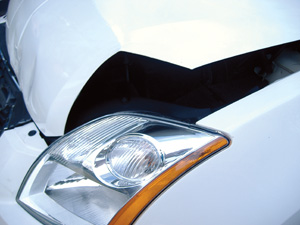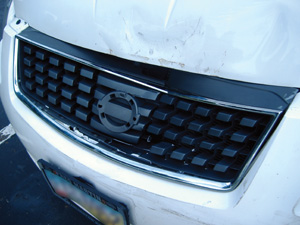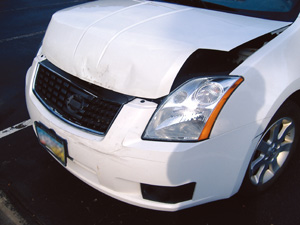 Shop No. 1
Shop No. 1
We had driven by this shop several times on the way to Subway for lunch and always wondered what it was like. Only a few miles from the office, it seemed the perfect first stop to take our front-end damaged 2007 Nissan Sentra.
The first thing we noticed was that it was not obvious where we should pull up. It seemed fairly logical, however, to park next to what looked like the front office.
The office was not the cleanest we’ve been in. It was rather drab, with your typical car calendars and an interesting bunch of local sports souvenirs, which we felt was a nice show of community support, but didn’t do much for the décor.
“You know there’s a new shop that opened on the East Side of Cleveland that has an art gallery in the customer reception area?” we said.
“Hah! Not here!” said a guy working the phones.
Right off, it seemed the estimator was bothered, distracted and cantankerous. The first thing he did was look out the window at the car and say, “In order to do a complete and thorough estimate, I will have to pop the hood, and it may not go back down. Otherwise, I’m only going to be able to write what I see.”
Okay, quick thinking. That might be fine if we were dead set on having the car fixed there, but we needed to drive it around to at least three more shops for the purposes of this article. So we replied, “Just write what you see then.”
We also told him we’d like to pay out-of-pocket if possible. At the next shop, we figured we would say we wanted to file an insurance claim. Maybe at the next we would say we were undecided.
The estimator went out to inspect the damages. While writing the estimate, he speculated on whether the radiator and condenser were damaged. We wondered about the A/C, to which he said, “Does it work?”
“Yes,” we replied.
“Well?”
Again, sort of a condescending and smart-aleck tone. Not appreciated.
He told us he could “ala carte” the repair if we wanted, selecting what to repair and what not to repair.
“Y ou can see the radiator cap and all the damage,” he said. “Given that you’re trying to keep it as tight as possible, I can spec it out and go with straightening or replacing what I need to where the hood locks down and then leave the radiator. When we open the car up, we’ll probably find more stuff, and you can either approve it or not approve it. If you notice, the fender is bent up, which is not a big deal, but it is displaced.”
ou can see the radiator cap and all the damage,” he said. “Given that you’re trying to keep it as tight as possible, I can spec it out and go with straightening or replacing what I need to where the hood locks down and then leave the radiator. When we open the car up, we’ll probably find more stuff, and you can either approve it or not approve it. If you notice, the fender is bent up, which is not a big deal, but it is displaced.”
The grille had to be replaced, he said, and it was more important than addressing the bumper cover, which was smeared with black. We asked if the hood could be straightened.
“No, it totally has to be replaced,” he said. “These are designed to do exactly what it did, which is not go into the interior.”
We played dumb, saying we heard there were non-original parts we could use to save money.
“Yes, you can get those, absolutely,” he said.
We asked if he thought there was frame damage.
“No, you hit it high enough,” he said.
Regarding the energy absorber in the bumper, he said, “If I was doing it for the insurer, I would replace it.”
“Why?” we asked.
“Because I’m obligated to get your vehicle to pre-accident condition.”
He also let us know that he could only spend so much time on our estimate.
“If you’re considering copy stuff (aftermarket parts), I say we write it like that. I will look up a hood and tell you what Nissan charges and what the copy price is and you can decide which way to go,” he said. “But I have to draw a line on how much time I will spend on this estimate. Also, we could go used, but that is more expensive than copy parts but not as expensive as OEM.
He then went on to explain a little how insurance companies work.
“We’re primarily an insurance shop, and we know how they want us to write these things. First, they want us to find used stuff. But with front-end stuff, this is a typical accident, so there’s not a lot of used stuff out there. Some companies refuse to use aftermarket copy stuff, but others do.”
Once we w crash-up our 2007 nissan sentra got into.”/>ere back in the office and he handed us the estimate, we once again brought up straightening the hood. We asked why he couldn’t just “bang it out,” and he seemed pretty annoyed.
crash-up our 2007 nissan sentra got into.”/>ere back in the office and he handed us the estimate, we once again brought up straightening the hood. We asked why he couldn’t just “bang it out,” and he seemed pretty annoyed.
“Modern vehicles are designed with crush zones, and once those zones are compromised, it’s a safety-related item,” he said. “You might be able to find some hillbilly somewhere to do it, but if that’s the case, you might as well leave now.”
His parting advice to us was, “Shop for estimates and go with the cheapest one is what I recommend if this is the way you want to go.”
At some point while he was writing the estimate, we asked him how business was. He said they were “three weeks out,” which we professed surprise at since it was summer and we thought more accidents happened in winter due to the weather.
“There are more accidents in winter, but they occur at smaller speeds,” he said. “In summer, people drive faster and tear things up more, which means the jobs are more expensive.”
Another note: the phone rang during our conversation, and he answered it, “ABC Auto Body.” That’s exactly the way customer service experts say you shouldn’t answer the phone! A better way would be, “It’s a great day at ABC Auto Body, how may we assist you today?”
Going over the estimate, he explained certain things. Blend, for instance. He explained that he wanted to paint over the top edges of the fenders and clear the fenders completely so the hood would match.
“There are some things I will compromise on, but that’s not one of them,” he said.
Going over the estimate, he also said, “If you go to a real shop that has a computerized estimating system, all those prices and numbers should be the same. My judgement is where you’re going to save some money.”
Addressing the front-end damage, he said, “The radiator support is bent back. To get the hood to open and close properly, and get the lock in the right spot and the radiator and condenser back in line with each other, we need to repair that. Some companies sell those parts but with Nissan, it’s all one part, so we have to take the front part of the car off and replace it, which is $380. Therefore, I opted to straighten it. It will be functional and safe and look good when we’re done, but there’s no parts price because we’re not replacing it. We’ll do four hours, and we need to put it on a bench before we start on the car. We’ll tie it down and pull the nose of the car out to the proper length and measure that.
“Aftermarket stuff tends to rust more quickly, so we’ll do corrosion protection because we want to protect the hood. Anything we touch, we’ll give a lifetime guarantee. I want to make sure it’s protected so that if you do come back in three years and it’s rusting, I’ll know I did as much as I could for you.”
He finished by saying that the estimate total ($1,655.92) was as close as he could cut it, and that any full repair would easily cost a third more. He also added this:
“Don’t share that with the insurer because then they’ll say, ‘Why can’t you fix the car for that amount for us?’ And this estimate is not fixing your car.”
Shop No. 2
What we liked about Sh op No. 2 was that they had a covered, drive-up estimating bay that we could easily identify as where we should go. This was a dealer shop, and walking into the office, we were immediately impressed by its cleanliness and neatness.
op No. 2 was that they had a covered, drive-up estimating bay that we could easily identify as where we should go. This was a dealer shop, and walking into the office, we were immediately impressed by its cleanliness and neatness.
The first thing the estimator said was, “What insurance company is this going to be?”
We answered, “We’re not sure if we’re going to file a claim, but we think we probably will.”
“I was going to say, if you’re going with insurance, I’ll put you in a rental car,” the estimator said.
The estimator was very quiet throughout the inspection, really not saying much. He did say that he couldn’t tell if the radiator was broken, but he could see the condenser was “messed up.” He also said the radiator looked “twisted” and cautioned that our car could overheat.
“It’s really going to be hard to write an estimate on it because I can’t get the hood up,” he said. “But we have to replace the hood for sure.”
He ran down a list of parts he thought it needed: radiator support, hood, front bumper cover and grille. He said the radiator support would be the “costly ticket.”
“More than likely, however, there will be hidden damage,” he said. “It doesn’t look like anything is leaking right now, but keep watch when you’re out driving.
“The worst case scenario is if you get into the radiator and condenser. There really won’t be a whole lot more labor than what’s already on the estimate, so if we get into all this other stuff, you’re probably looking at $3,200. [The items] on that estimate right now is what you need…unless you don’t want to do the front bumper, that’s your call.”
We asked him if the estimate would be any lower if we wanted just a “cosmetic” repair to make everything look good on the outside and ignore the inside.
“You can’t forget about the inside,” he said. “You have to have the radiator and everything straightened up to make it fit right. Otherwise, it wouldn’t be the proper way to fix the car.
“Once we get into it, we might find that we can do it for less. But it looks like the radiator support is pretty boogered up. That’s a structural part of the car and holds the whole front-end together. There is zero tolerance on those Nissans when you put those cars together. Everything has to be right where it’s at.”
We then asked how long the repair would take, and he said six to seven days unless they found more damage after tearing the vehicle down.
Shop No. 3
At the third body shop we visited, another dealer shop, we ran into an estimator who undoubtedly was the most aggressive of the day. As soon as we got out of the car, he was right on top of us. In fact, we asked if he worked there, thinking he was just a person getting into the car next to us. He was very intimidating looking, too, and wasn’t dressed very professionally, either.
He didn’t take much time to assess the damage and throw out a figure he felt would return the car to pre-accident condition: $4,500, by far the largest estimate of the day. He immediately observed that the radiator core support was shoved back into the engine compartment, and, like the last estimator, pointed out that it was “hazardous to drive the car in this condition because it could overheat.”
“The problem is, I need to lift the hood to see,” he said. “Once I do that, [the vehicle’s] done. You’re not driving it.”
We asked if he could just write what he saw, and he said no because that would be an “absolute disservice” to us.
“There is probably $2,000 I can’t see, things I know will be wrong with it,” he said. Pointing to the hood, he said, “You’re impairing your vision right here. If the cops see this, they’ll pull you over and give you a ticket. You’re taking your life in your hands and others. This is a safety issue. You have a lot of things going on here that you need to be aware of.”
We then told him that we wanted to get a few estimates before making a decision.
“Are you interested in going with the cheapest? If you are, it won’t be me. I can assure you of that, absolutely hands-down, no discussion.”
He then questioned whether, at $4,500, we really wanted to pay out of pocket. “And I honestly think it will be more than that,” he said.
“We write down what’s wrong with it on the estimate. We don’t pay attention to prices until we put it into the system. There’s the fix-it-right way and fix-it-wrong way. We’ll find more wrong with this car. We could tear it apart and find another $1,500, which is normal – especially with a car like this with a bunch of plastic in front.”
Like at Shop No. 1, we asked if the hood had to be replaced or if it could be hammered out. The reaction was similar.
“Seriously? Really? No, dude, it’s junk. There’s right and wrong, and wrong isn’t an option here, period. I see cars fixed by the wrong people every day. If someone attempts to do that, you go down the road and the hood flies up because it was fixed improperly. The way these cars are made today, it’s almost always strictly ‘replace.'”
This guy by far put the hardest sell on us. He again told us about the safety factor.
“If you deal with it now, you won’t have to deal with it later. The last thing you want to do is get out of town and then have issues with it. You don’t want to continue driving this vehicle because of the hidden damage factor. Continuing to drive this vehicle could cause additional damage.”
We told him about how we had already gotten a couple estimates, and one was $1,600. That set him off laughing to the point we thought he was going to roll off his chair. He said he knew of the shop and said they do “tons” of insurance work.
“The game they play is a common game in the industry, and that’s ‘the cheapest estimate wins.’ I’ve already admitted I won’t be that guy,” he said. “What they want to do is get you in the door. Then, they’ll tear the vehicle apart and find more because now you’re committed.”
“Did he look to see if the radiator and condenser were bad? Did he notice the core support was shoved back? The upper tie bar where everything hooks up is destroyed, the hood hinges are bad, the hood latch, the radiator and condenser. I can’t tell if the fan is bad but it’s shoved back and there’s a good chance it’s damaged, so the cooling of this vehicle won’t work out right.”
When he finally presented the estimate to us, it was $5,134 – higher than his eyeball estimate of $4,500. He seemed very impressed with himself that he got so close. Then, he gave us a little lesson on how insurers operate.
“Insurers will try to push you around and tell you where to go,” he said. “Now, when they do that, do you think it’s for your benefit or theirs? It’s for their benefit. They get a discount.”
He then went on to present his shop as better than insurance shops because it isn’t “hooked up” with any insurers.
“I don’t want to give people the impression that I’m in cahoots with someone and beg someone for business,” he said. “I have one insurer I work with, and there are no deals. This insurer has had horrible experiences with local shops in the area. We fix it right the first time.”
He said he worked for a shop years ago that did a ton of insurance work and had 16 employees, but he prefers his current situation now.
“It’s more personal here,” he said. “When you come in the door here, you’re a human being first, then you’re a customer.”
We told him we were surprised that, as soon as we opened our car door, he was there.
“When you came in, you obviously had a problem, so I figured I might as well go out and meet you in the lot. Why wouldn’t I just step right out there and take care of you? I’m going to be going out there anyway.”
We brought up aftermarket parts, and he said it didn’t make much sense in this scenario.
“It would only change the price by $300, and when you’re this deep in the car, is it that much of a difference?” he said.
“If you took this estimate to other shops and told them I wrote this and I was crazy, they would help sell that to you. But the end result here is when this car is done, I’ll bet my price will be a lot closer to the real price than the other guys.”
“I’m going to be as honest as I can. Is everyone going to see things as I do? Absolutely not. That’s why you should get two to three more estimates. Make your own decision, don’t let the insurer steer you unless it’s a shop you’ve talked to and feel comfortable with. Make the insurer go to the shop to see your vehicle. Commit to the repairs so the car has to be disassembled to expose all damage. What the insurer would like to do is commit you to another shop or see you somewhere else and write an estimate for, say, $1,600. Then the shop finds additional damage and your car sits there waiting for the insurer to come back out, so time is an issue.”
And now, the moment of truth. Just before we left, he made us sign a form stating that he told us the vehicle was unsafe to drive, releasing the shop of all liability.
“This protects me after you take the car out of here after I told you it was unsafe to drive and the hood comes off and you sue me,” he said.
We thought this was the best sales tactic yet because it scared us. We literally wanted to stop driving around and head back to the office. But we didn’t because we had one more shop to visit.
Shop No. 4
The next stop was in the “sticks,” as they say. We half expected a rabid dog like Cujo to charge at us. It was very hard to find, and we passed the sign several times because it was very hard to read. We pulled up and noticed some stock cars in the yard…and also noticed the place was pretty dirty. A man strolled out slowly with a coffee mug in one hand, eyeballing the front of the car.
We told him we wanted to pay out of pocket if possible. If you recall, the estimator at Shop No. 1 said any “real” shop has a computerized estimating system. Well, this wasn’t a real shop then, since the only evidence of a computer we found was a forlorn tower sitting on top of a desk with its power cord wrapped around it. The estimator, who was the owner of the shop, hand wrote the sheet, looking up parts prices in a book and making a few phone calls.
“Looks like the hinges and stuff are okay,” he said. “I’m going to take a guess and say the hood latch is okay.”
Gulp. Really? What if it isn’t? We heard the estimator from the last shop’s voice in our heads: “Don’t take any chances.”
We asked if he could beat the hood out.
“No, no, no,” he said, laughing.
After his inspection, he said he felt like all it needed was a hood, grille and license plate bracket.
“I figured to repaint the bumper,” he said. “I think we can reuse the bumper cover.”
He, like everyone else, noticed that the top part of the radiator support was pushed back and said they would have to pull it forward. “I think the latch is probably okay,” he reiterated.
One peculiar thing he referred to was a “non-Nissan part.” We asked what that was, and he said, “It’s a used part, but a non-Nissan part.” Did that mean used aftermarket?
Conclusion
On our drive back to the office, we went over some of the things we learned. There was a wide disparity between each shop we visited. Each one had their own way of doing things, whether it was writing the estimate, handling the customer or selling. Each shop had a different setup and look. Some had a long way to go to be perceived as professional businesses, while some were already there. We sensed which ones might not last in the current market, and which ones were positioned for future success. We left wondering if this disparity is a good thing or a bad thing. If the customer experience suffers as a result, we decided, it’s a bad thing.














